1994 CHEVROLET CAVALIER air condition
[x] Cancel search: air conditionPage 194 of 243
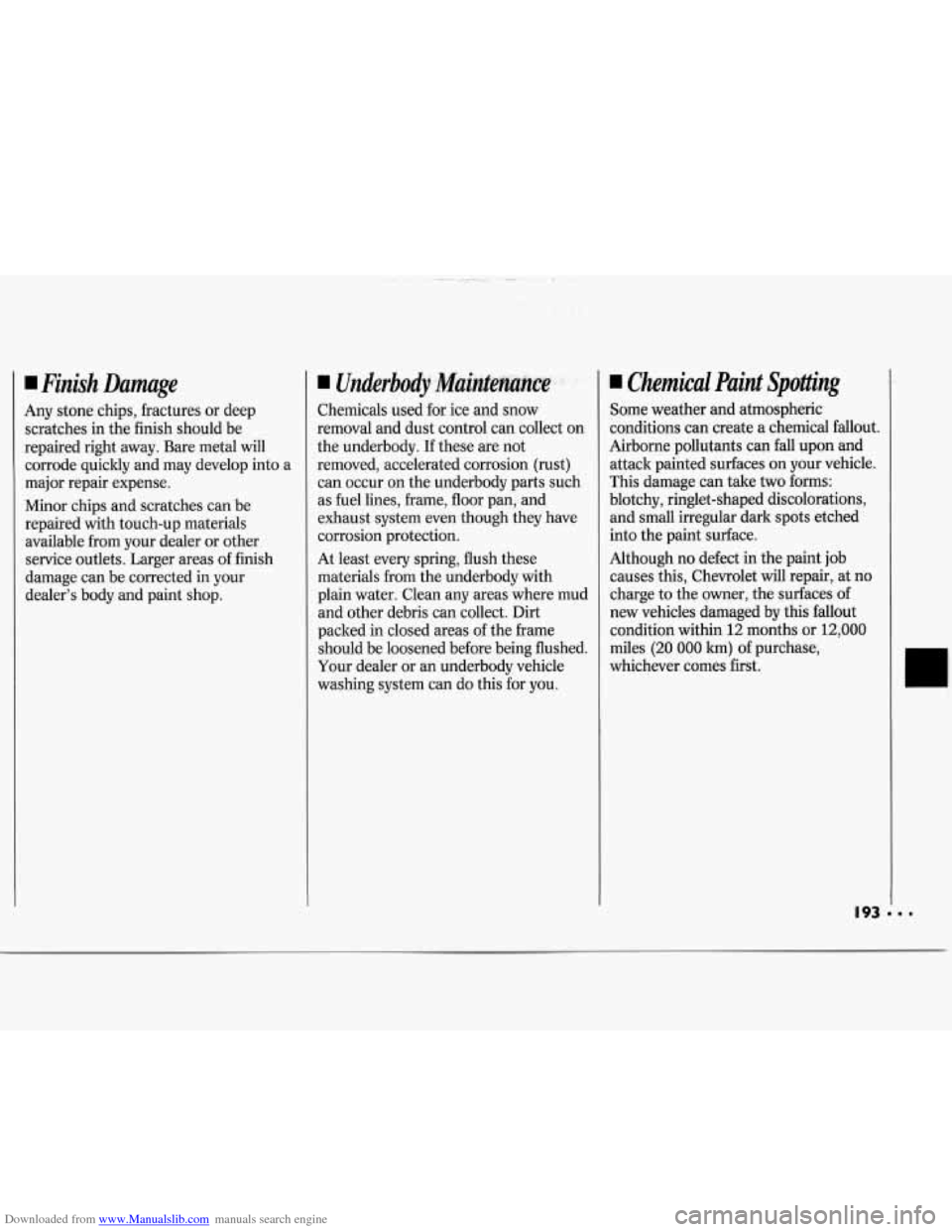
Downloaded from www.Manualslib.com manuals search engine Finish Damage
Any stone chips, fractures or deep
scratches in the finish should be
repaired right away. Bare metal will corrode quickly and may develop into a
major repair expense.
Minor chips and scratches can be
repaired with touch-up materials
available from your dealer or other
service outlets. Larger areas of finish
damage can be corrected in your
dealer's body and paint shop.
Underbody Mahtenanm . :
Chemicals used for ice and snow
removal and dust control can collect on
the underbody.
If these are not
removed, accelerated corrosion (rust)
can occur on the underbody parts such
as fuel lines, frame,
floor pan, and
exhaust system even though they have
corrosion protection.
At least every spring, flush these
materials from the underbody with
plain water. Clean any areas where mud
and other debris can collect.
Dirt
packed in closed areas of the frame
should be loosened before being flushed.
Your dealer or
an underbody vehicle
washing system can do this for you.
Chemical Paint Spotting
Some weather and atmospheric
conditions can create
a chemical fallout.
Airborne pollutants can fall upon
and
attack painted surfaces on your vehicle.
This damage can take
two forms:
blotchy, ringlet-shaped discolorations, and small irregular dark spots etched
into the paint surface.
Although no defect in the paint job
causes this, Chevrolet will repair, at no
charge to the owner, the surfaces
of
new vehicles damaged by this fallout
condition within 12 months or 12,000
miles
(20 000 km) of purchase,
whichever comes first.
Page 199 of 243
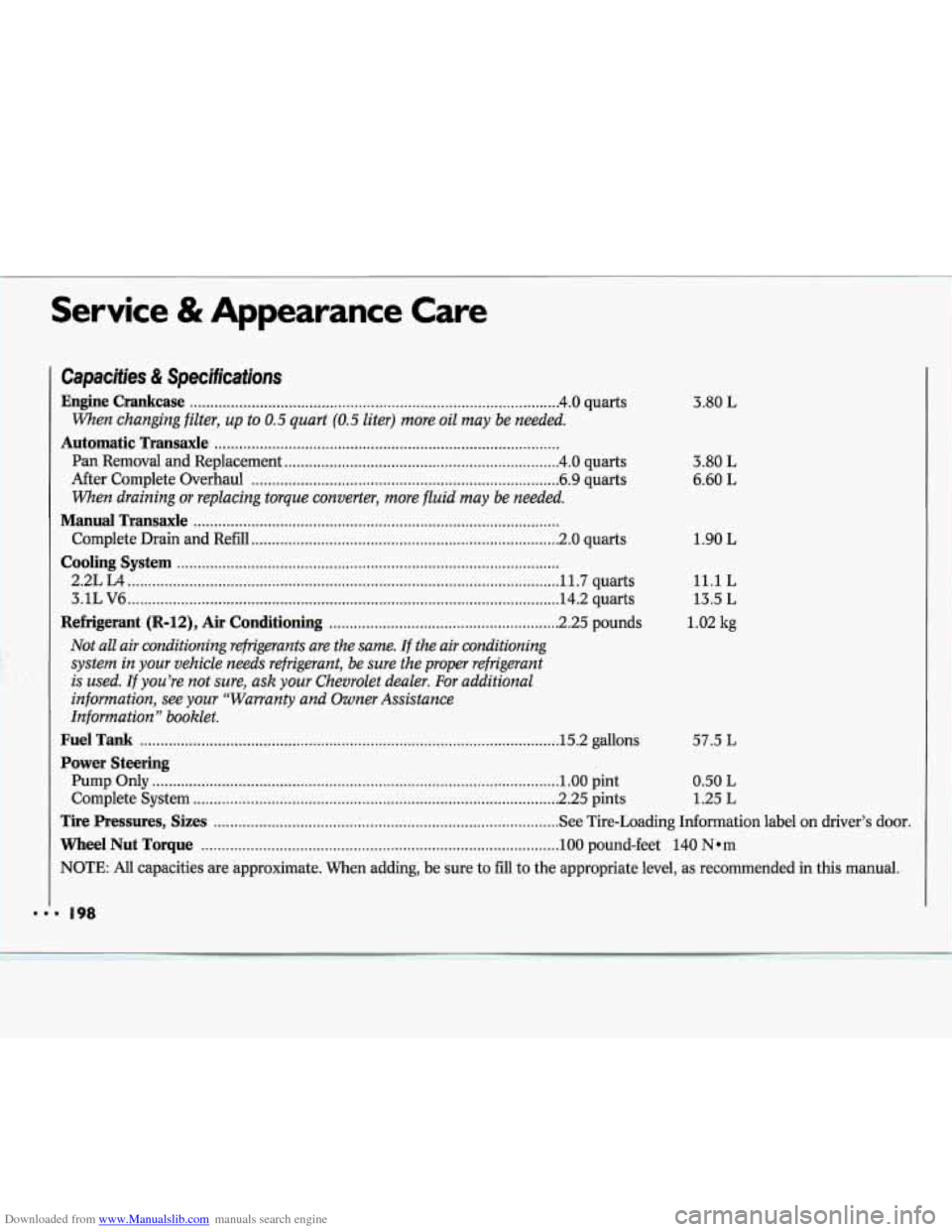
Downloaded from www.Manualslib.com manuals search engine Service & Appearance Care
Capacities & Specifications
Engine Crankcase ........................................................................\
.................. 4.0 quarts
When changing filter, up to 0.5 quart (0.5 liter) more oil may be needed.
Automatic Transaxle ........................................................................\
............
Pan Removal and Replacement ................................................................... 4.0 quarts
After Complete Overhaul
........................................................................\
... 6.9 quarts
When draining or replacing torque converter, more fluid may be needed.
Manual Transaxle ........................................................................\
.................
Complete Drain and Refill ........................................................................\
... 2.0 quarts
Cooling System ........................................................................\
.....................
2.2L L4 ........................................................................\
................................. 11.7 quarts
3.1L V6
........................................................................\
................................. 14.2 quarts
Refrigerant (R-12), Air Conditioning ........................................................ 2.25 pounds
Not all air conditioning refrigerants are the same. If the air conditioning
system in your vehicle needs refrigerant, be sure the proper refrigerant
is used. If you’re not sure, ask your Chevrolet dealer. For additional
information, see
your “Warranty and Owner Assistance
Information
” booklet.
Fuel Tank ........................................................................\
............................. .15.2 gallons
Power Steering
Pump Only ........................................................................\
........................... 1.00 pint
Complete System
........................................................................\
................. 2.25 pints 3.80
L
3.80
L
6.60 L
1.90
L
11.1 L
13.5 L
1.02 kg
57.5 L
0.50 L
1.25 L
Tire Pressures, Sizes ........................................................................\
............ See Tire-Loading Information label on driver’s door.
Wheel Nut Torque ........................................................................\
............... 100 pound-feet 140 Nom
NOTE: All capacities are approximate. When adding, be sure to fill to the appropriate level, as recommended in this manual.
Page 205 of 243
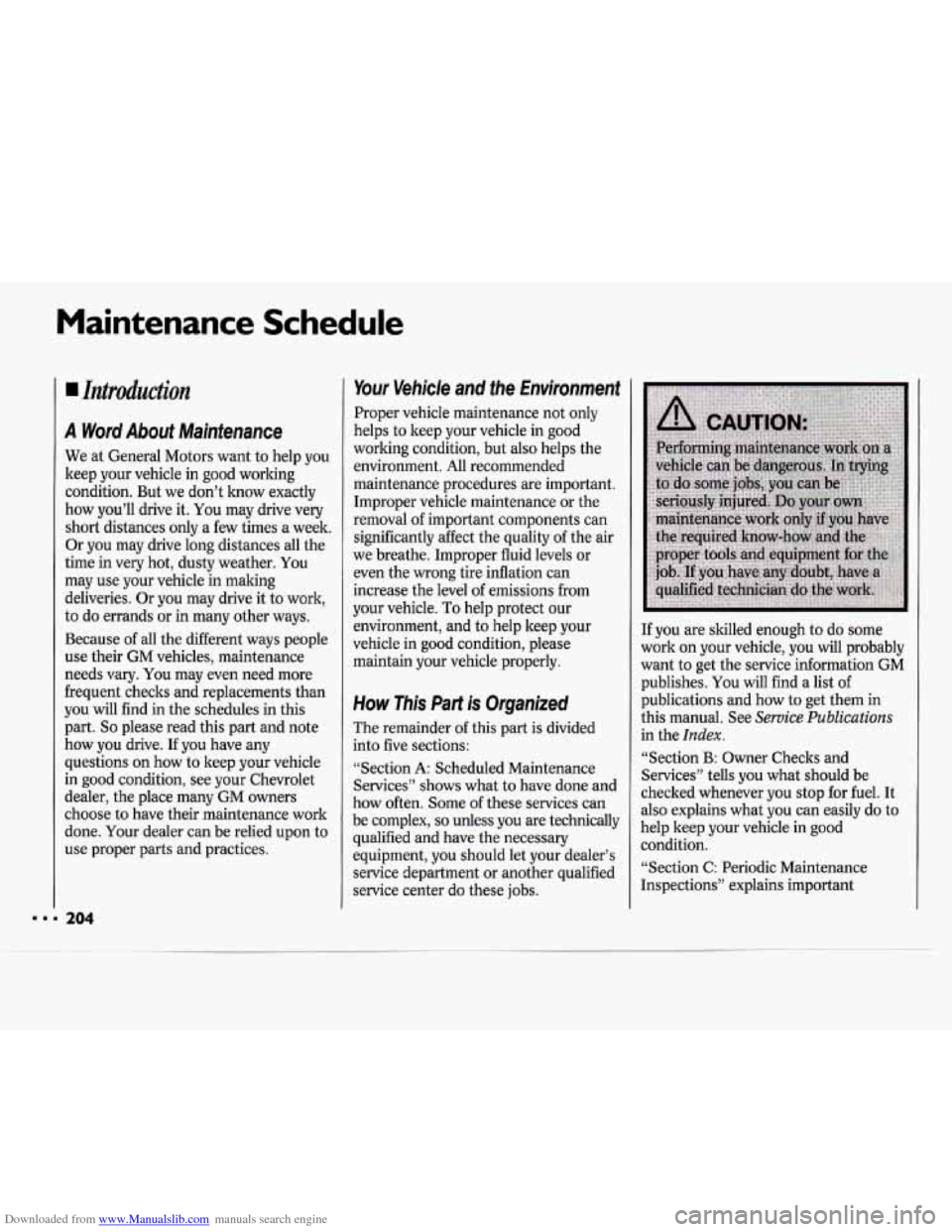
Downloaded from www.Manualslib.com manuals search engine Maintenance Schedule
BB
A Word About Maintenance
We at General Motors want to help you
keep your vehicle in good working
condition. But we don’t know exactly
how you’ll drive it. You may drive very
short distances only a few times a week.
Or you may drive long distances all the
time in very hot, dusty weather. You
may use your vehicle in malting
deliveries. Or you may drive it to work,
to do errands
or in many other ways.
Because of all the different ways people
use their GM vehicles, maintenance
needs vary. You may even need more
frequent checks and replacements than
you will find in the schedules in this
part.
So please read this part and note
how you drive. If you have any
questions on how to keep your vehicle
in good condition, see your Chevrolet
dealer, the place many
GM owners
choose to have their maintenance work
done. Your dealer can be relied upon to
use proper parts and practices.
204
Your Vehicle and the Environment
Proper vehicle maintenance not only
helps to keep your vehicle in good
working condition, but also helps the
environment. All recommended
maintenance procedures are important.
Improper vehicle maintenance or the
removal of important components can
significantly affect the quality of the air
we breathe. Improper fluid levels or
even the wrong tire inflation can
increase the level
of emissions from
your vehicle.
To help protect our
environment, and to help keep your
vehicle in good condition, please
maintain your vehicle properly.
How This Part is Organized
The remainder of this part is divided
into five sections:
“Section A: Scheduled Maintenance
Services” shows what to have done and
how often. Some
of these services can
be complex,
so unless you are technically
qualified and have the necessary
equipment, you should let your dealer’s
service department or another qualified
service center do these jobs. If
you are skilled enough to do some
work on your vehicle, you will probably
want to get the service information GM
publishes. You will find a list of
publications and how
to get them in
this manual. See
Service Publications
in the Index.
“Section B: Owner Checks and
Services” tells you what should be
checked whenever you stop for fuel. It
also explains what you can easily do to
help keep your vehicle in good
condition.
“Section
C: Periodic Maintenance
Inspections” explains important
Page 206 of 243
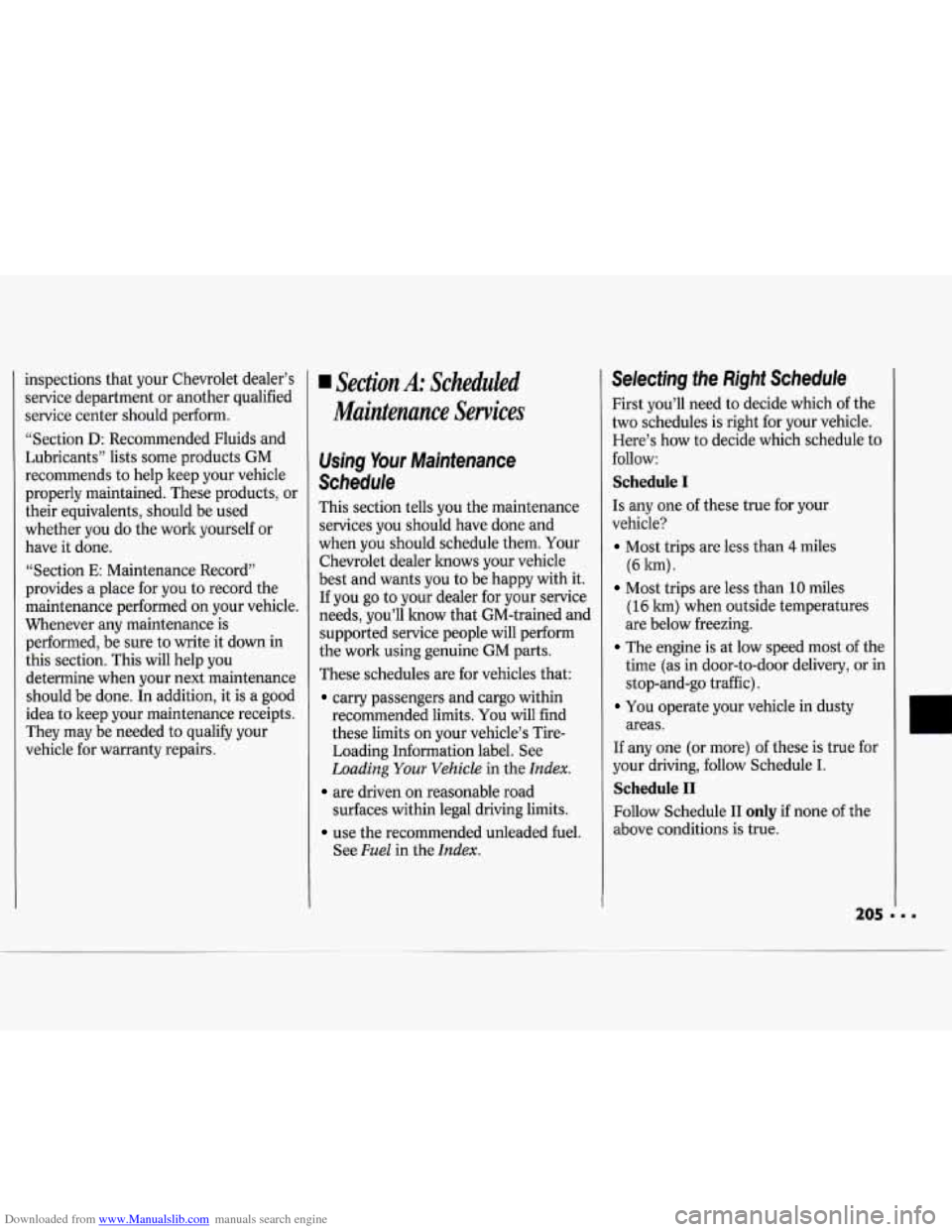
Downloaded from www.Manualslib.com manuals search engine inspections that your Chevrolet dealer’s
service department or another qualified
service center should perform.
“Section
D: Recommended Fluids and
Lubricants” lists some products
GM
recommends to help keep your vehicle
properly maintained. These products, or
their equivalents, should be used
whether you do the work yourself or
have it done.
“Section
E: Maintenance Record”
provides a place for you to record the
maintenance performed
on your vehicle.
Whenever any maintenance
is
performed, be sure to write it down in
this section. This will help you
determine when your next maintenance should be done. In addition, it is a good
idea to keep your maintenance receipts.
They may be needed to qualify your
vehicle for warranty repairs.
Section A: Scheduled
Maintenance Services
Using Your Maintenance
Schedule
This section tells you the maintenance
services you should have done and
when you should schedule them. Your
Chevrolet dealer knows your vehicle
best and wants you to be happy with
it.
If you go to your dealer for your service
needs, you’ll lmow that GM-trained and
supported service people will perform
the work using genuine GM parts.
These schedules are for vehicles that:
carry passengers and cargo within
recommended limits. You will find
these limits on your vehicle’s Tire-
Loading Information label. See
Loading Your Vehicle in the Index.
are driven on reasonable road
surfaces within legal driving limits.
use the recommended unleaded fuel.
See
Fuel in the Index.
Selecting the Right Schedule
First you’ll need to decide which of the
two schedules is right for your vehicle.
Here’s how to decide which schedule to
follow:
Schedule I
Is any one of these true for your
vehicle?
Most trips are less than 4 miles
Most trips are less than 10 miles
(6 la).
(16 km) when outside temperatures
are below freezing.
The engine is at low speed most of the
time (as in door-to-door delivery, or in
stop-and-go traffic).
areas.
You operate your vehicle in dusty
If any one (or more) of these is true for
your driving, follow Schedule
I.
Schedule I1
Follow Schedule I1 only if none of the
above conditions is true.
Page 207 of 243
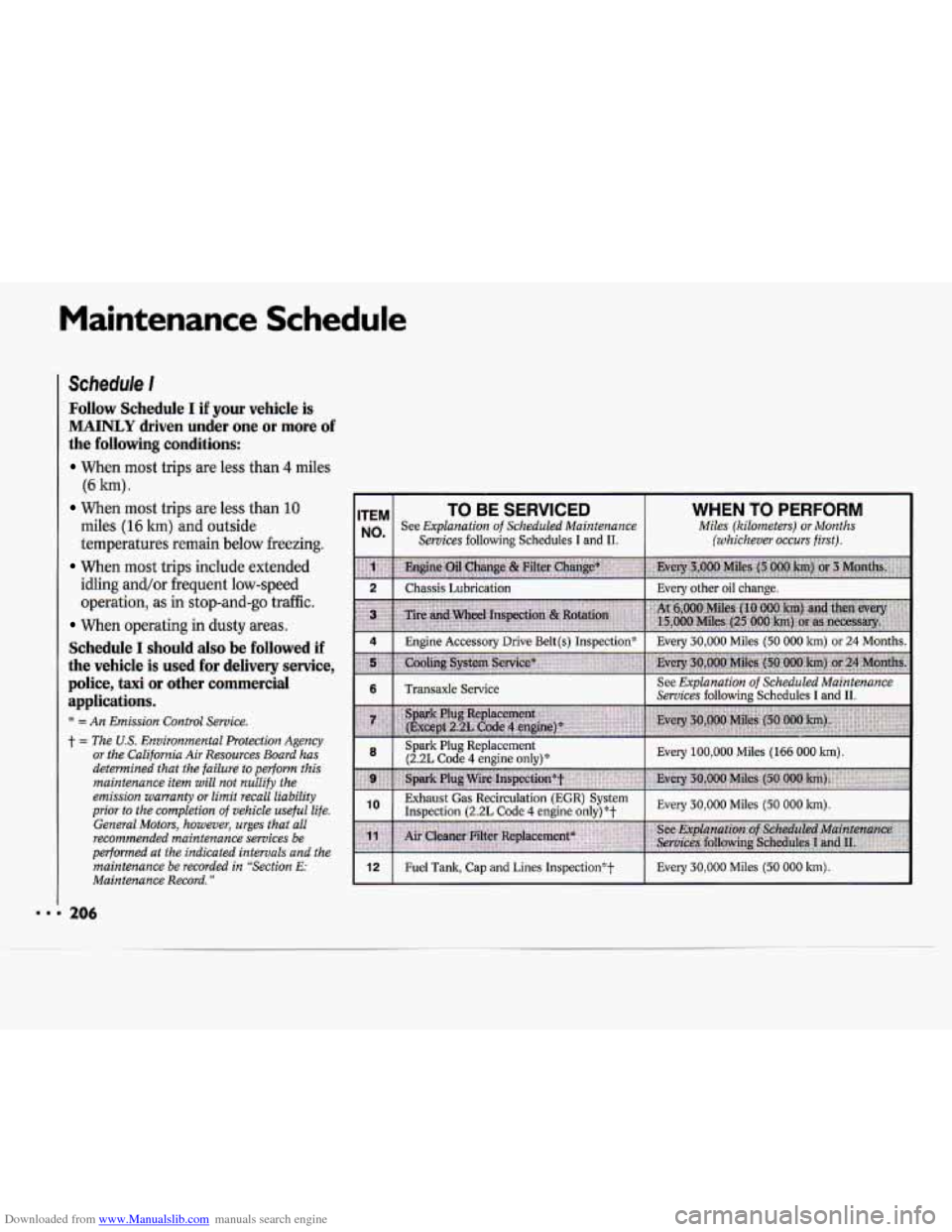
Downloaded from www.Manualslib.com manuals search engine Maintenance Schedule
Schedule I
Follow Schedule I if your vehicle is
MAINLY driven under one or more of
the following conditions:
When most trips are less than 4 miles
When most trips are less than 10
(6
km).
miles
(16 ltm) and outside
temperatures remain below freezing.
When most trips include extended
idling and/or frequent low-speed
operation, as in stop-and-go traffic.
When operating in dusty areas.
Schedule I should also be followed if
the vehicle is used for delivery service,
police, taxi
or other commercial
applications.
* = An Emission Control Service.
t = The US. Environmental Protection Agency
or the California Air Resources Board has
determined that the failure to perform this
maintenance item
will not nullify the
emission warranty
or limit recall liability
prior to the completion
of vehicle useful life.
General Motors, however, urges that all
recommended maintenance services be
performed at the indicated intervals and the maintenance be recorded in “Section
E:
Maintenance Record. ”
ITEM
Services following Schedules I and 11. Nom
TO BE SERVICED
See Explanation of Scheduled Maintenance
WHEN TO PERFORM
Miles (kilometers) or Months
(whichever occurs first).
I 2 I Chassis Lubrication I Every other oil change. I
I 4 I Engine Accessory Drive Belt(s) Inspection* I Every 30,000 Miles (50 000 km) or 24 Months. I
Page 209 of 243
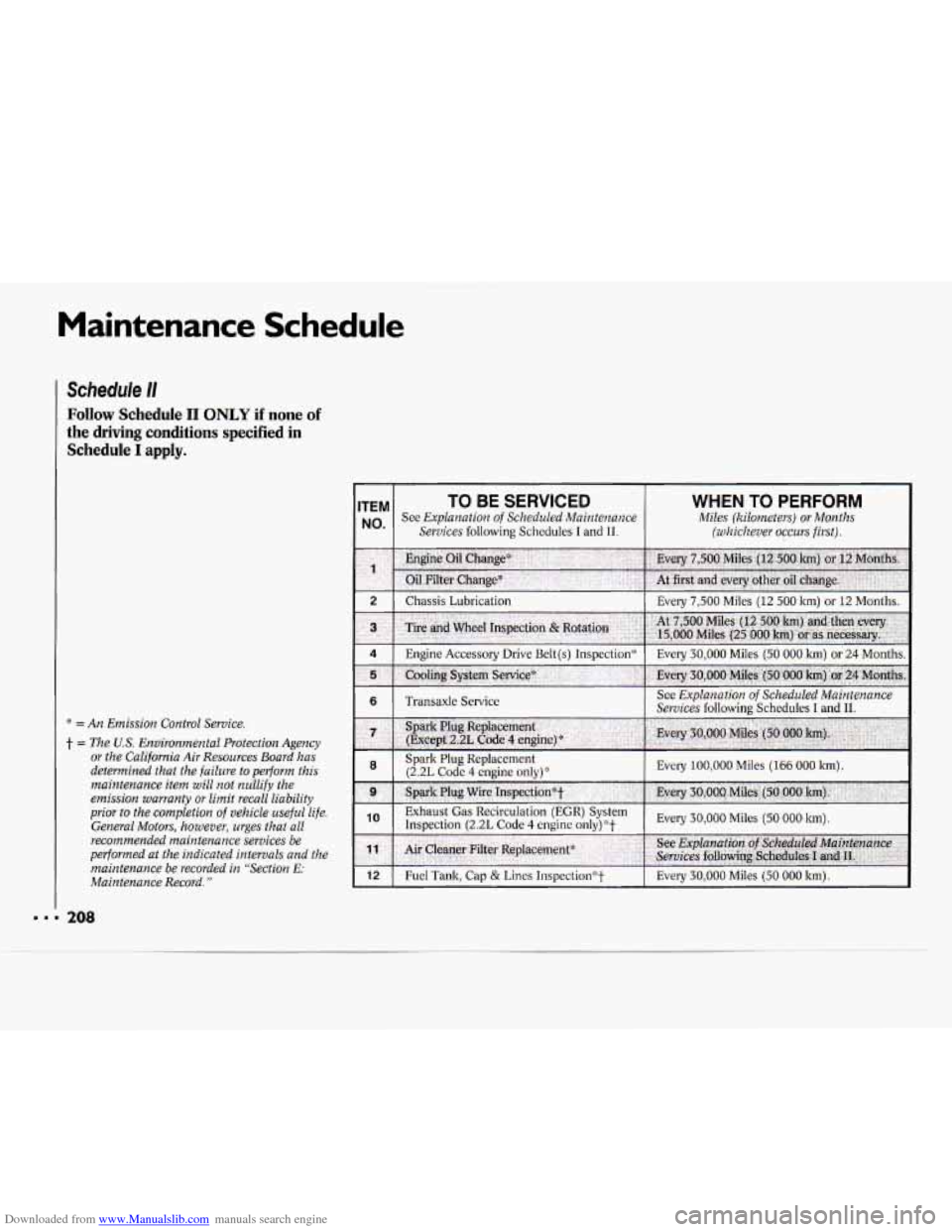
Downloaded from www.Manualslib.com manuals search engine Maintenance Schedule
Schedule /I
Follow Schedule I1 ONLY if none of
the driving conditions specified in Schedule
I apply.
* = An Emission Control Service.
t = The US. Environmental Protection Agency
or the California Air Resources Board has
determined that the failure to perform this
maintenance item will not nullify the
emission
warranty or limit recall liability
prior to the completion of vehicle useful life.
General Motors, however, urges that all
recommended maintenance services be
performed
at the indicated intervals and the
maintenance be recorded in "Section
E:
Maintenance Record."
TEM TO BE SERVICED
No' See Explanation of Scheduled Maintenance
Services
following Schedules I and 11.
WHEN TO PERFORM
Miles (kilometers) or Months
(zuhichever occurs first).
2 I Chassis Lubrication I Everv 7.500 Miles (12 500 lun) or 12 Months.
12 I Fuel Tank, Cap & Lines 1nspection"t I Every 30,000 Miles (50 000 km).
Page 211 of 243
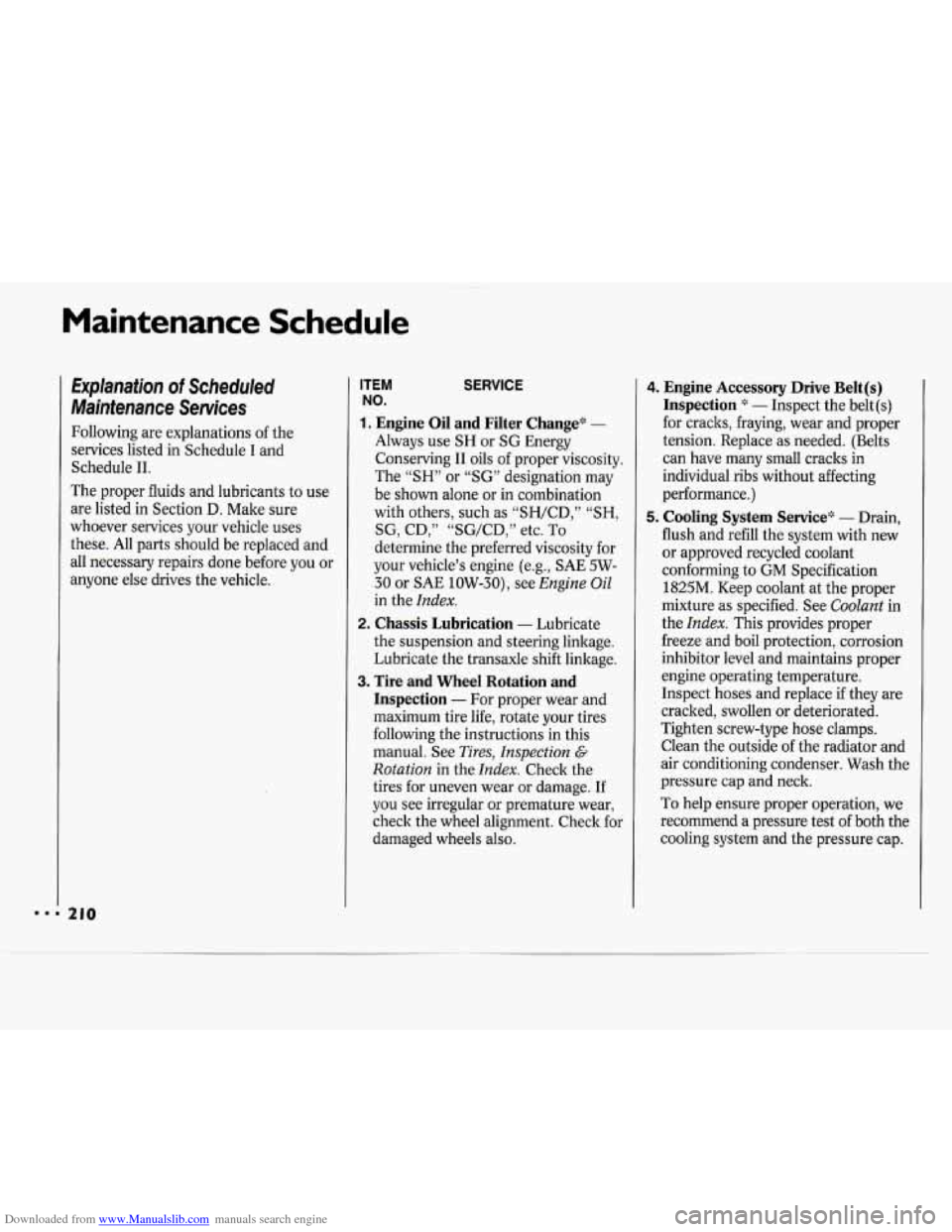
Downloaded from www.Manualslib.com manuals search engine Maintenance Schedule
Explanation of Scheduled
Maintenance Services
Following are explanations of the
services listed in Schedule
I and
Schedule 11.
The proper fluids and lubricants to use
are listed in Section
D. Make sure
whoever services your vehicle uses
these. All parts should be replaced and
all necessary repairs done before you or
anyone else drives the vehicle.
ITEM SERVICE
NO.
1. Engine Oil and Filter Change* -
Always use SH or SG Energy
Conserving I1 oils of proper viscosity.
The
“SH” or “SG” designation may
be shown alone or in combination
with others, such as “SH/CD,”
“SH,
SG, CD,” “SG/CD,” etc. To
determine the preferred viscosity for
your vehicle’s engine (e.g., SAE 5W-
30 or SAE 10W-30), see
Engine Oil
in the Index.
the suspension and steering linkage.
Lubricate the transaxle shift linkage.
Inspection - For proper wear and
maximum tire life, rotate your tires
following the instructions in this
manual. See
Tires, Inspection G
Rotation in the Index. Check the
tires for uneven wear or damage. If
you see irregular or premature wear,
check the wheel alignment. Check for
damaged wheels also.
2. Chassis Lubrication - Lubricate
3. Tire and Wheel Rotation and
4. Engine Accessory Drive Belt(s)
Inspection
* - Inspect the belt (s)
for cracks, fraying, wear and proper
tension. Replace as needed. (Belts
can have many small cracks in
individual ribs without affecting
performance.)
5. Cooling System Service* - Drain,
flush and refill the system with new
or approved recycled coolant
conforming to
GM Specification
1825M. Keep coolant at the proper
mixture as specified. See
Coolant in
the
Index. This provides proper
freeze and boil protection, corrosion
inhibitor level and maintains proper
engine operating temperature.
Inspect hoses and replace if they are
cracked, swollen or deteriorated.
Tighten screw-type hose clamps.
Clean the outside of the radiator and
air conditioning condenser. Wash the
pressure cap and neck.
To help ensure proper operation, we
recommend a pressure test
of both the
cooling system and the pressure cap.
Page 212 of 243
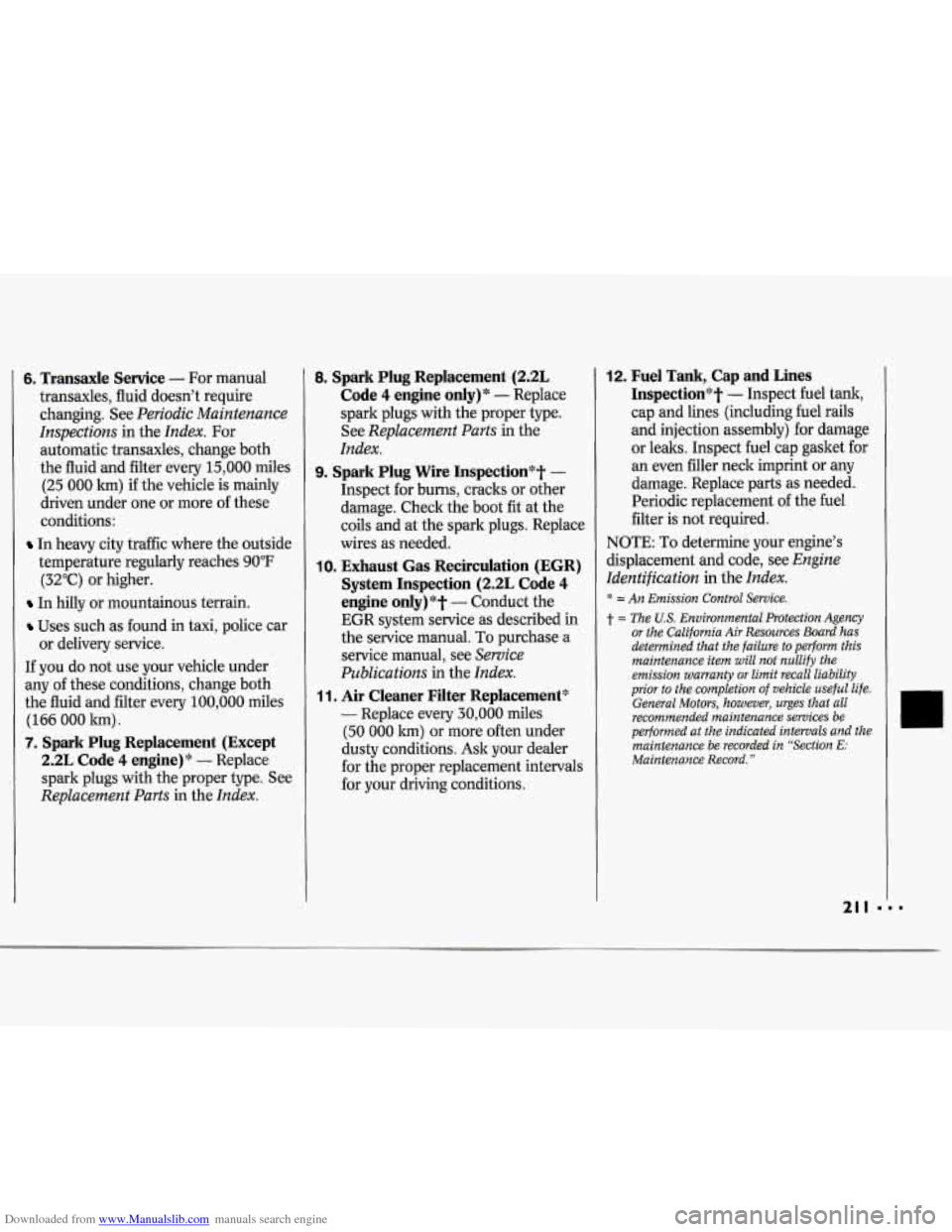
Downloaded from www.Manualslib.com manuals search engine 6, Transaxle Service - For manual
transaxles, fluid doesn’t require
changing. See
Periodic Maintenance
Inspections
in the Index. For
automatic transaxles, change both
the fluid and filter every 15,000 miles
(25
000 km) if the vehicle is mainly
driven under one or more of these
conditions:
In heavy city traffic where the outside
temperature regularly reaches 90°F
(32°C) or higher.
In hilly or mountainous terrain.
Uses such as found in taxi, police car
If you do not use your vehicle under
any of these conditions, change both
the fluid and filter every 100,000 miles
(166
000 lun).
7. Spark Plug Replacement (Except
2.2L Code
4 engine)* - Replace
spark plugs with the proper type. See
Replacement Parts in the Index.
or delivery service.
8. Spark Plug Replacement (P.2L
Code 4 engine only)* - Replace
spark plugs with the proper type.
See
Replacement Parts in the
Index.
9. Spark Plug Wire Inspection*t -
Inspect for burns, cracks or other
damage. Check the boot
fit at the
coils and at the spark plugs. Replace
wires as needed.
IO. Exhaust Gas Recirculation (EGR)
System Inspection (2.2L Code
4
engine only)*? - Conduct the
EGR system service as described
in
the service manual. To purchase a
service manual, see
Service
Publications
in the Index.
1 1. Air Cleaner Filter Replacement*‘
- Replace every 30,000 miles
(50
000 km) or more often under
dusty conditions. Ask your dealer
for the proper replacement intervals
for your driving conditions.
12. Fuel Tank, Cap and Lines
Inspection’#t
- Inspect fuel tank,
cap and lines (including fuel rails
and injection assembly) for damage
or leaks. Inspect fuel cap gasket for an even filler neck imprint or any
damage. Replace parts as needed.
Periodic replacement of the fuel
filter is not required.
NOTE: To determine your engine’s
displacement and code, see
Engine
Identification
in the Index.
* = An Emission Control Service.
t = The U.S. Environmental Protection Agency
or the California Air Resources Board has
determined that the failure to perform this
maintenance item will not nullify the
emission warranty
or limit recall liability
prior to the completion of vehicle useful life.
General Motors, however, urges that all
recommended maintenance services be
performed at the indicated intervals and the
maintenance be recorded in “Section
E:
Maintenance Record.”